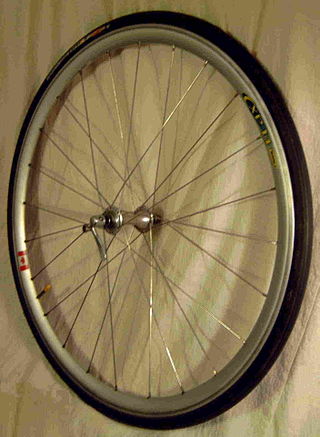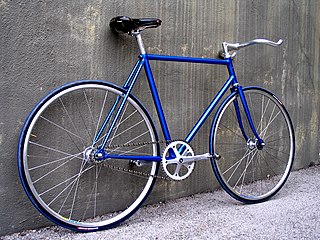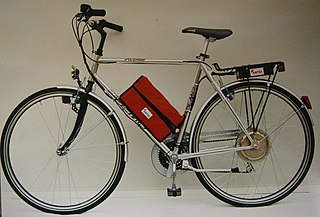Related Research Articles

A bicycle, also called a pedal cycle, bike, push-bike or cycle, is a human-powered or motor-powered assisted, pedal-driven, single-track vehicle, having two wheels attached to a frame, one behind the other. A bicycle rider is called a cyclist, or bicyclist.

A tandem bicycle or twin is a form of bicycle designed to be ridden by more than one person. The term tandem refers to the seating arrangement, not the number of riders. Patents related to tandem bicycles date from the mid 1880s. Tandems can reach higher speeds than the same riders on single bicycles, and tandem bicycle racing exists. As with bicycles for single riders, there are many variations that have been developed over the years.

A recumbent bicycle is a bicycle that places the rider in a laid-back reclining position. Some recumbent riders may choose this type of design for ergonomic reasons: the rider's weight is distributed comfortably over a larger area, supported by back and buttocks. On a traditional upright bicycle, the body weight rests entirely on a small portion of the sitting bones, the feet, and the hands.

A tricycle, sometimes abbreviated to trike, is a human-powered three-wheeled vehicle.

The penny-farthing, also known as a high wheel, high wheeler or ordinary, is an early type of bicycle. It was popular in the 1870s and 1880s, with its large front wheel providing high speeds, owing to it travelling a large distance for every rotation of the legs, and comfort, because the large wheel provided greater shock absorption.

A bicycle wheel is a wheel, most commonly a wire wheel, designed for a bicycle. A pair is often called a wheelset, especially in the context of ready built "off the shelf" performance-oriented wheels.

The bottom bracket on a bicycle connects the crankset (chainset) to the bicycle and allows the crankset to rotate freely. It contains a spindle to which the crankset attaches, and the bearings that allow the spindle and crankset to rotate. The chainrings and pedals attach to the cranks. Bottom bracket bearings fit inside the bottom bracket shell, which connects the seat tube, down tube and chain stays as part of the bicycle frame.

A track bicycle or track bike is a bicycle optimized for racing at a velodrome or outdoor track. Unlike road bicycles, the track bike is a fixed-gear bicycle; thus, it has only a single gear ratio and has neither a freewheel nor brakes. Tires are narrow and inflated to high pressure to reduce rolling resistance.

A bicycle fork is the part of a bicycle that holds the front wheel.

A fixed-gear bicycle is a bicycle that has a drivetrain with no freewheel mechanism such that the pedals always will spin together with the rear wheel. The freewheel was developed early in the history of bicycle design but the fixed-gear bicycle remained the standard track racing design. More recently the "fixie" has become a popular alternative among mainly urban cyclists, offering the advantage of simplicity compared with the standard multi-geared bicycle.

Vehicles that have two wheels and require balancing by the rider date back to the early 19th century. The first means of transport making use of two wheels arranged consecutively, and thus the archetype of the bicycle, was the German draisine dating back to 1817. The term bicycle was coined in France in the 1860s, and the descriptive title "penny farthing", used to describe an "ordinary bicycle", is a 19th-century term.

On a bicycle, the cassette or cluster is the set of multiple sprockets that attaches to the hub on the rear wheel. A cogset works with a rear derailleur to provide multiple gear ratios to the rider. Cassettes come in two varieties, freewheels or cassettes, of which cassettes are a newer development. Although cassettes and freewheels perform the same function and look almost the same when installed, they have important mechanical differences and are not interchangeable.

An electric bicycle is a motorized bicycle with an integrated electric motor used to assist propulsion. Many kinds of e-bikes are available worldwide, but they generally fall into two broad categories: bikes that assist the rider's pedal-power and bikes that add a throttle, integrating moped-style functionality. Both retain the ability to be pedaled by the rider and are therefore not electric motorcycles. E-bikes use rechargeable batteries and typically are motor-powered up to 25 to 32 km/h. High-powered varieties can often travel more than 45 km/h (28 mph).
Dahon is the world's largest manufacturer of folding bicycles with a two-thirds marketshare in 2006. The company was founded in 1982 by David T. Hon, a former laser physicist, and is headquartered in Los Angeles, California, with assembly factories in China, Macau and Bulgaria. Dahon markets bicycles under its own name as well as other brand names, including the affiliated Yeah and Biceco Brands, and Novara for REI in the U.S. The company is a member of the Global Alliance for EcoMobility. Dahon holds over 200 patents, some having become industry standards.
Montague Corporation is an American company that designs, manufactures, and sells full-size folding bicycles. It is headquartered in Cambridge, Massachusetts.

Bamboo bicycles are pedal-and-chain-driven, human-powered, single-track vehicles that have two wheels attached to a bamboo frame. Because of its light weight, vibration damping, and sustainability, bamboo is slowly starting to be used in bicycle frame production, though the industry is still dominated by aluminium frames.

A wooden bicycle is a bicycle constructed either mostly, or entirely from wood. Wood was the material used in the earliest bicycles, and is also used by modern builders, especially in balance bicycles for children. The wood can be either solid or laminate.

KMC Chain Industrial Co., Ltd. is a roller chain manufacturer headquartered in Taiwan, R.O.C. with corporate entities in the US, Continental Chain Company, and Europe, KMC Chain Europe BV. They make cam driving chains, balance driving chains, oil pump chains, motorcycle chains, and industrial chains. They manufacture and market bicycle chains and master links under their own KMC brand and supply them to others, including Shimano. KMC chains are used in the Tour de France by riders such as Gustav Larsson, Swedish time trial champion. KMC was founded by Charles Wu in 1977, and was the largest bicycle chain manufacturer in the world in 2011.
Cruzbike is a brand of recumbent bicycles based in Newburyport, Massachusetts, United States. The company was founded in 2005 and all models are now designed in the United States and manufactured in Taiwan. Cruzbike started life in Australia and was featured on the ABC show The New Inventors. It is fairly unusual in that it makes a front-wheel drive recumbent bicycle with a Moving Bottom Bracket (MBB). The bottom bracket is the piece that the pedals attach to, and in this case it moves left and right with the front wheel when steering the bicycle. This design allows for better climbing ability, and eliminates "heel strike" on turns, but comes with a slightly longer learning curve as there is a pedal-steer effect.
References
- ↑ !00% Wood
- ↑ Irvine, Dean (2011-05-30). "Wooden 'SplinterBike' aims to set world speed record". CNN. Retrieved 2013-12-11.
- 1 2 Ennew, Kirsty (2011-04-27). "The wooden bike – an engineering marvel, a recipe for saddle sore". The Guardian. Retrieved 2013-12-11.
- ↑ Ridden, Paul (2011-05-10). "Splinter Bike - a bicycle built ENTIRELY out of wood". Gizmag. Retrieved 2013-12-11.
- 1 2 Sparkes, Matthew (2013-11-21). "Wooden bikes: not as barking as it sounds". The Telegraph. Retrieved 2013-12-11.